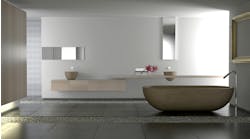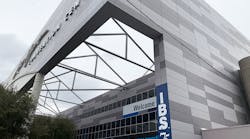Latest from Kitchen & Bath Industry Show
Better Behind the Wall = More Choices in the Front
Designhounds Events Recap: KBIS Uncorked 2024
Sponsored
Design and Construction Week Defrosts Chilly Vegas
I left Chicago’s O’Hare—headed for Design & Construction Week in Vegas—in a blizzard and touched down at McCarron Intl. to a spattering of light rain and snow. But the chilly temps didn’t put a damper on one of the best shows since the two associations started exhibiting together. This may sound too cliche, but the buzz was palpable. While in the working press room, I overheard one National Association of Home Builders (NAHB) exec say that the show was the best in terms of income, booth number and size, and attendance projections—since the economic downturn.=
In fact, the numbers are in, and they suggest that those word-of-mouth numbers didn’t lie. According to the information from the National Association of Home Builders (NAHB), the International Builders’ Show (IBS) drew the largest crowd in 10 years. More than 67,000 home building professionals from around the world filled the exhibit halls, and the IBS and the Kitchen & Bath Industry Show (KBIS) once again combined for the annual Design & Construction Week, which drew a total of more than 100,000 attendees.
Inside the Trends
It has been my contention that the bigger these shows are—size and attendance—generally the healthier the economy, with interest high and consumer confidence up. However, the “2019 Housing & Economic Outlook” press conference, spearheaded by NAHB Chief Economist Robert Dietz, painted a more cautious approach to the industry. Growing concerns with housing affordability coupled with supply-side constraints will limit single-family output to modest gains in 2019, according to stats coming from Housing & Economic Outlook press conference. “Ongoing job creation and solid household formations will keep demand firm, but builders will continue to grapple with supply-side headwinds that will dampen more vigorous growth in the single-family sector,” said Dietz.
NAHB says that builders are dealing with a lack of workers; a shortage of buildable lots; regulations; tariffs on lumber and other key building materials; and a slow growth in acquisition, development and construction loan activity that is failing to keep pace with demand. All of these factors, plus home price appreciation over the past year that has outpaced wage gains, are contributing to rising affordability woes in the housing sector.
Yet, remodeling appears to be steady. Residential remodeling activity is projected to increase in the future, but at a softening rate of 4 percent growth in 2019 followed by a 2 percent gain in 2020. NAHB predicts that remodeling spending for owner-occupied single-family homes will increase 1.6 percent in 2019 and another 1.1 percent in 2020.
Show officials also conveyed that spending on residential improvements will continue to grow over the next two years at a gradual pace. Professional remodelers from across the country agreed with the forecast, citing increased consumer confidence and demand.
For 2018, NKBA estimates residential construction will rise to $683 billion, up 6 percent from 2017. A further 4.8 percent growth is projected for 2019, bringing the residential construction market to $716 billion.
"Remodeler confidence continues to remain at a high level, as remodeling spending reached $172 billion in 2018," said 2018 NAHB Remodelers Chair Joanne Theunissen, CGP, CGR, a remodeler from Mt. Pleasant, Mich. "Although there is steady consumer demand in all areas of the country, the biggest challenges continue to be the costs of labor and materials to meet the interest."
While multifamily housing starts in 2018 came very close to the sector's 2015 peak, production levels are expected to moderate somewhat in 2019 and will stabilize in a range that that is considered normal, according to data announced by NAHB.
"Multifamily starts will begin to level off through 2019, edging 2 percent lower this year at about 379,000 units, approaching the level that was the pre-recession norm," said Danushka Nanayakkara-Skillington, AVP, Forecasting and Analysis for NAHB. "The great majority of 2018's units were in buildings with 50 or more apartments."
The National Kitchen & Bath Association (NKBA) released the results of its extensive “Size of Market Study and Outlook,” revealing a value of $644 billion in sales of products and materials aimed at the residential kitchen and bath market in 2017. This total includes $330 billion from the construction of new homes and $314 billion from residential remodeling and replacement projects. Construction of new houses rose 8.6 percent in 2017, to reach a market size of $330 billion. Remodeling and improvement of existing homes amounted to $314 billion in 2017. This is 6.4 percent higher than it was in 2016.
NAHB announced other K&B trends, which include farmhouse styles incorporating ample amounts of wood; engineered quartz countertops for color flexibility; vinyl and resilient flooring, especially for aging in place; wireless controls, and open interior and exterior spaces in the kitchen; and higher-end fixture installations in the bathroom, such as wall-mounted sinks, faucets and toilets.
The NKBA estimates the U.S. residential construction market will continue to expand in both 2018 and 2019. For 2018, NKBA estimates residential construction will rise to $683 billion, up 6 percent from 2017. A further 4.8 percent growth is projected for 2019, bringing the residential construction market to $716 billion.
An over-arching outlook on the economy, David Berson, senior vice president and chief economist at Nationwide Insurance, said there is a low risk of a near-term recession. However, he said that economic growth is expected to slow modestly this year in response to trade/tariff issues, higher interest rates and diminishing fiscal stimulus from the 2017 passage of the Tax Cuts and Jobs Act.
Berson expects the Federal Reserve to tighten interest rates two or three times this year, with fewer moves in future years. This anticipated action, along with inflation edging higher, should result in a modest rise in 30-year mortgage rates in 2019.


